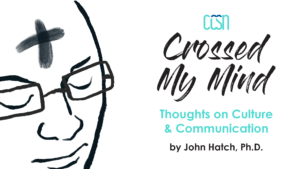 Crossed My Mind: Thoughts on Culture and Communication
Crossed My Mind: Thoughts on Culture and Communication
By John Hatch, Ph.D.
Eastern University (retired)
CCSN Senior Fellow
Column Description: As Christians, we are called to have the mind of Christ. This goes against the grain of our social and cultural conditioning. We seek personal or political advancement; Christ seeks the lost and the least. We grasp for cultural ascendency; Christ descends to the cross of love. This column is dedicated to thinking about culture and communication under the sign of the cross.
January 2023 / December 2022 / November(2) 2022 / November 2022 / October 2022 / August-September 2022 / June-July 2022 / January 2022 / December 2021 / October-November 2021
January 2023
Talking About Race: Truthfully, Lovingly, Productively
Martin Luther King Jr. famously lamented that 11 o’clock on Sunday morning was “the most segregated hour in America.” Sadly, improvement since then has not been nearly as widespread or deep as we might have hoped. Even churches that explicitly set out to reflect the racial/ethnic diversity of God’s children in the society around them often fall short of making all colors fully welcome, all voices fully heard, all hearts at home. The hyper-politicized environment infecting much of the Christian community over the last dozen years has made many black Americans in majority-white churches feel even less welcome, and after years of faithfully trying to “be the bridge,” many have given up and have sought refuge in the black church.
A major reason for this tragic state of affairs is our inability to talk—truthfully, lovingly, and productively—about race. Whenever an incident of police or citizen violence against a black or brown individual explodes across the mediascape, the politicization of race leaves many white people numb to the real emotional pain felt by many people of color, and they respond insensitively. Moreover, a lack of teaching or modeling on best practices for talking about race results in a default mode of silencing or marginalizing such conversations.
This situation provoked Isaac Adams—a black evangelical and lead pastor of a majority-white, multicultural church in Birmingham, Alabama—to write Talking About Race: Gospel Hope for Hard Conversations. In his preface, Adams writes, “I aimed to write a book pastors could hand to their people without having to make ten qualifications.”[1] I believe he succeeded. Although it connects most readily with evangelicals, I’d encourage Christians of any stripe to read Talking About Race. Here are eight reasons why.
This book offers an honest, holistic look at the church’s vexed racial conversations. Like Frederick Buechner in Telling the Truth, Adams confronts the messy, multi-layered reality of his subject. Instead of dividing the church into racial heroes and villains or offering cut-and-dried answers, the author presents the situation in living color, raises questions, offers options, and ultimately looks to God—not formulas or sociopolitical programs—for truth, justice, grace, and peace in the world.
To illustrate the complex reality of racial controversies, Adams presents a fictional story about an unarmed black man being shot by police and a diverse congregation’s attempt to respond to it. Within the story, we encounter well-meaning, flawed human beings who grapple with a very difficult situation in starkly different ways. As the narrative unfolds, we are reminded that there are many sides to a story and we shouldn’t expect these conversations to be easy. Having the opportunity to look over characters’ shoulders and listen in on their conversations takes our own self-image out of the cross-hairs long enough to empathize with them, instead of putting up mental defenses. Like Christ’s parables, the story draws us in and provokes self-reflection.
The diversity of the characters’ racial identities, ideological leanings, and church roles allows a wide array of readers to recognize aspects of themselves within the story. Across the narrative, we encounter a white man who is gun-shy (based on past experience) about discussing race; his black fellow-congregant, who is weary of having to explain his concerns in a majority-white church; a politically conservative bank manager, who believes we should focus on poverty, not race; her “woke” younger sister, who is angry about her church’s tepid response to the shooting; a second-generation Korean-American, who feels marginalized by the black-white focus that dominates conversations about race; and their pastor, discouraged by congregants’ complaints and even departures from the church for contradictory reasons (it gives too little attention to race and diversity, or it places too much focus on these matters). Adams devotes a whole chapter to each character, portraying them in their complex humanity. The characters’ internal dialogues help us see the pains, fears, and thought processes behind their responses.
The author offers hypothetical pastoral counsel to each character. Each one’s story (including the fictional pastor’s) is followed by a substantial section titled “Encouragement For [So-and-So],” which lays out the counsel Adams would give. Taking the sandwich approach, he begins by identifying evidences of God’s grace in their life and commending any positive actions or intentions they’ve exhibited in the situation; then, he gently corrects any misperceptions on their part, backed by factual information and explanations, and follows with positive recommendations on how to act and communicate more helpfully. Thus, wherever a reader finds themselves within the scenario, they come away equipped to better understand and respond.
Part 2 of Talking About Race addresses bigger-picture questions about race conversations in the church, offering answers grounded in the truth of Scripture as well as the realities of human psychology and communication. Adams discusses why Christians should talk about race across color lines, why this is hard to do, and how we should approach these difficult conversations. In the process, he avoids simplistic answers. For example, he unpacks 11 reasons why it is so hard to talk across color lines, suggests what we can do about each one, and then lists 13 more. His answer to the “how” question is similarly thorough, discussing 12 ways in which we should approach race conversations: biblically, humbly, locally, kindly, prayerfully, justly, patiently, carefully, impartially, truthfully, realistically, and hopefully. Prayer receives particular emphasis.
The author presents hard truths with grace, humility, and a passion for the unity of the church. Instead of labeling people racists, Adams acknowledges the diverse forces and ideas that could lead a reasonable (if misguided) person to think and act as they do. He counsels characters in the story not only with correctives (such as “You trippin’,” “History is not color-blind,” and “Listen first”) but also affirmations (such as “You’re not crazy,” “You are tired,” and “You’re forgiven”). Even when discussing the importance of sound doctrine, he warns against being “the overbearing heresy patrol” in race conversations.[2]
Talking About Race is framed as a workbook for personal reflection, action, and growth. Each chapter ends with “Questions for Reflection and Discussion,” and the author exhorts readers to take time to write out their answers before moving to the next chapter. The book concludes with a chapter on what we can do when the next racial tragedy happens and an afterword on how parents can talk about race with their children.
The author’s response to racial division in the church is hopeful yet realistic. Adams encourages readers to hope in God and act on that hope; yet he is a realist about the limitations of human efforts and relieves us of the burden of “solving” racial division ourselves. He advises the pastor in the story not to “fixate on making your church more diverse,” since increasing diversity, though a worthy goal, is a complex challenge and isn’t the primary purpose of the church.[3] To black Christians discouraged by their experience in majority-white churches, the author affirms their freedom in Christ either to stay for the hard work of inclusion and reconciliation or move to a black church for strength and encouragement.
In short, Talking About Race is honest, nuanced, full of wisdom, and pastoral. This unique book both challenges and empowers us to do a better job of talking about race in the church. Above all, it models the grace needed to confront this challenge. If enough people read and take it to heart, we’ll have a better chance of bridging the church’s stubbornly persistent racial divide.
Notes
[1] Isaac Adams, Talking About Race: Gospel Hope for Hard Conversations (Grand Rapids, MI: Zondervan Reflective, 2022), xiii-xiv.
[2] Adams, Talking About Race, 122.
[3] Adams, Talking About Race, 100.

